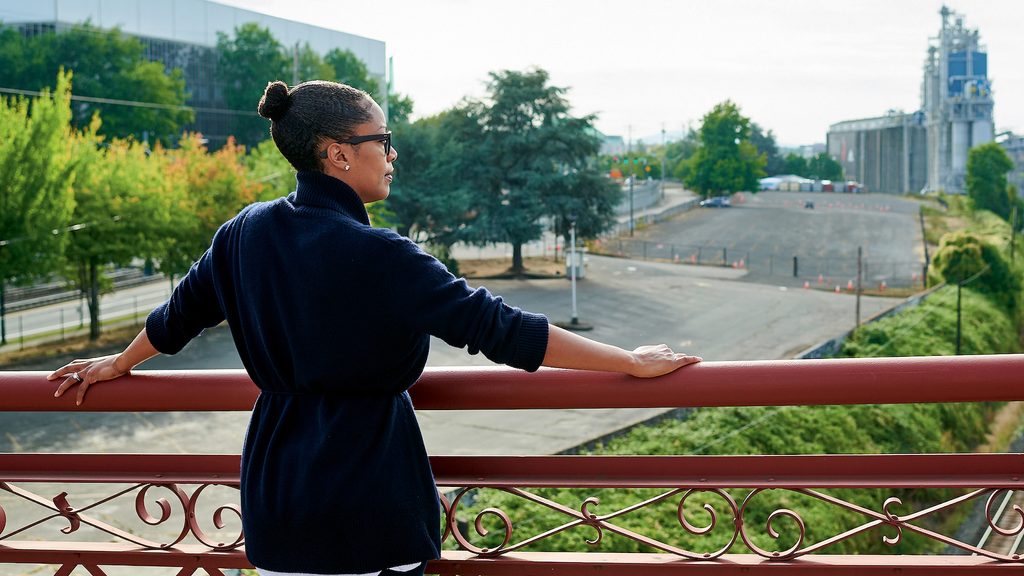
Vision Quest
Rekaiyah Adams ’95 grew up in a loving, tight-knit community in Portland, Oregon after her great-grandmother moved there from Louisiana during World War II. This friendly neighborhood underwent many changes in the time Adams left after graduating Carleton – mostly changes for the worse. Wanting to rebuild what she experienced for others, Adam’s left her high-powered job to commit towards restoring her historically black neighborhood.
Rukaiyah Adams ’95 left a high-powered finance career in Manhattan to return to her hometown of Portland, Oregon, where she is committed to restoring the city’s historically black neighborhood.
IF YOU ASK Rukaiyah Adams ’95 what she does for a living, she says, “I make money.” This is true: her job involves managing an $800 million fund for a Portland, Oregon, foundation that is rated in the top 10 percent for performance. She also has a high-stakes volunteer job chairing a committee that manages a $92 billion state fund for public employee pensions.
But this dollars-and-cents tally doesn’t capture the full picture. Adams is the public face for yet another project: a grassroots campaign called the Albina Vision, which she hopes will transform about 90 centrally located acres of the Portland cityscape through thoughtful, inclusive redevelopment. Though this is a volunteer job, it’s serious business, requiring her to stand her ground with government and development interests that have other ideas for the property. Adams doesn’t relish that part, but, she says, “I feel like I can’t back down.”
Some people see the Albina Vision as a way to reverse gentrification, a hot topic in Portland. But Adams sees it as continuing the legacy left by people like her great-grandmother.
INEZ ADKINS DAVIS had a grade school education and worked as a cook to support her family in Shreveport, Louisiana, before deciding to pick up and caravan northwest. Arriving in Portland, Davis and her kin found abundant flora, rejuvenating rains, and a river close enough to catch food for dinner and big enough to accommodate a World War II shipbuilding boom. Adams imagines what that felt like for the thousands of African Americans who migrated to Portland during this time. “My great-grandmother gazed across the river and thought she could build a community,” she says.
Discrimination kept African Americans out of most neighborhoods, so they settled in an area informally called Albina, which also was home to many immigrant families. Albina had a thriving downtown strip where middle-class white women and African Americans entered nightclubs through the same door. Compared to Louisiana, Adams says, “it must have been like landing on the moon.”
Davis and other members of her community were fleeing the choking restrictions of Jim Crow, violence, and poverty, but they were also moving toward a new vision.
“I live a lot of the life my great-grandmother imagined,” Adams says. And yet she can’t help feeling something has been lost between the generations.
Growing up in the 1970s and 1980s, Adams lived with her two brothers and their mom just down the block from Davis and other family members. The community, now mostly African American, was poor financially, but Adams saw its riches: neighbors looked out for neighbors and families went back generations. They enjoyed a wealth of community, and her great-grandmother’s generation helped build it.
Excelling in public school, Adams received a scholarship to attend an exclusive Portland private high school. Looking back, Adams believes she would have found her way even without the elite education, but the opportunity also gave her a sense of how people outside her social and economic milieu lived. When a Carleton recruiter came to campus, Adams was hooked by a photo of the chapel with the sun shining on colorful fall leaves. She arrived at Carleton in 1992.
Associate dean Liz Ciner was struck by Adams even then. “I remember her raising her voice to protest a whole bunch of things,” Ciner says. Though she wasn’t Adams’s adviser, Ciner worked with her on her senior comps project, which focused on public housing. Current research at the time suggested that moving low-income families to “scattered site” housing in mixed-income neighborhoods produced better outcomes than isolating poor people in public high-rises. But in her paper, Adams struggled with this concept. Growing up, Adams felt not hardship and blight, but the nurturing embrace of community. African Americans lost that if they scattered.

IN THE 1950s, construction began on I-5, which divided Albina and cut off the neighborhood’s access to the Willamette River. Ultimately, 476 homes and many businesses were razed to build a basketball stadium. In the 1960s, another 200 houses were demolished for a hospital expansion that never happened. The pain caused by forcing all of those families to move out of Albina still lingers in Portland today.
Watching Adams wrestle with the differences between the research and her own experience, Ciner was impressed. She recognized Adams’s “rich family background and community background that grounded her.” She saw how this young woman had grown even more through a first-rate education. “I wanted her to use her education to do good in the world, because I knew that’s what she wanted to do,” Ciner recalls.
As graduation approached, Adams agonized over what to do next. “Acquire power,” said Ciner, “and use it.”
“I remember thinking, that’s a little heavy,” Adams recalls. But she has held onto those words, turning them over in her mind, in the decades since.
She thought about them when she went to law school at Stanford, and then joined the high-powered law firm Skadden Arps, Slate, Meagher & Flom, where she specialized in mergers and acquisitions. She considered them when she returned to Stanford for an MBA. And she returned to them again when she became chief operating officer of a Manhattan asset management firm in 2009.
By then, the old neighborhood in Portland had been through even more change. In the late 1990s, a city-sponsored redevelopment plan had pushed out more African Americans to create opportunities for business interests and developers. Today, the homes in Albina are unaffordable to many of Adams’s old neighbors. It’s what happens when neighborhoods gentrify, and you can see it happening all over the country.
ABOUT EIGHT YEARS AGO, while she was home visiting her family, Adams went jogging and saw a man sitting on a bench looking despondent and surrounded by people asking for money and who appeared to be living on the street. The man was her younger brother. In her mind, she had been working so hard to ensure that her family’s basic needs were met. And yet, here he was—on a park bench alone. She began to see her time away from her hometown, family, and community as a kind of “moral failure.”
Once again, she returned to Ciner’s words. She thought about the community her great-grandmother helped build and how much it had invested in her education. And she thought, “What’s the point of my wonderful education? Is it just for me to amass wealth and live in a big house? The gift of access and education shouldn’t benefit only my family.”
And so, in 2012, Adams returned to Portland and became director of investment management at The Standard, an insurance company, and, later, chief investment officer at Meyer Memorial Trust, where she currently manages a large portfolio that funds efforts to create social equity.
And, through the Albina Vision, she’s working to restore some of what Davis saw when she came to Portland 70 years ago. At this point, the plan truly is a vision—one that spans 20, 30, even 50 years. Step one is lobbying government to put a cap on the freeway that divides the old neighborhood and move the basketball arena’s parking garages underground. This would create space for new homes, parks, and small businesses where there is currently a sea of concrete. They’re also looking for community-minded organizations to buy large pieces of property to build mixed-income housing. Separately, the city is devising incentives to help families who were displaced by the historical redevelopment projects to return to the area.
The Albina Vision has not yet drawn up specific proposals. Mainly, the goal is to be thoughtful and deliberate so as to avoid past mistakes. The last neighborhood to go through major redevelopment in Portland, known as the Pearl, was supposed to include affordable housing but instead is wildly expensive. So far, Portland mayor Ted Wheeler has supported the Albina Vision’s general goals of addressing affordability and displacement, and in April he committed to sussing out public opinion on the project.
Adams thinks often about her great-grandmother’s journey from the Deep South to the Pacific Northwest and how she might continue her family legacy. “My march is to push us toward community wealth,” she says. “That’s what my great-grandmother was trying to do.”